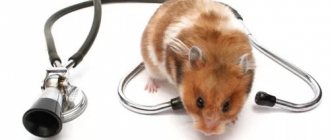Symptoms of hamster disease and how to cure it
The hamster is a favorite pet of children and adults. Unfortunately, he may suffer from dangerous diseases.
This will quickly relieve discomfort and provide your pet with the necessary living conditions. This is typical for all types of hamsters: Djungarian, Syrian, etc.
Lymphocytic choriomeningitis
The disease is transmitted to humans. The hamster becomes infected with it from mice. Djungarik can also become infected.
Young individuals are more likely to suffer from the disease, while in adults the disease occurs without severe symptoms.
The disease affects the respiratory system and provokes convulsions and paralysis. The virus is dangerous for people.
During pregnancy, a woman does not come into contact with a sick animal, because bacteria are dangerous for the development of the fetus. There is no vaccine for the infection. If treatment is not started in time, the disease negatively affects the functioning of the respiratory, digestive and genitourinary systems.
Lymphocytic choriomeningitis, photo
Infectious gastroenteritis
The pet needs urgent treatment. Otherwise, dehydration develops.
It is fatal. Treatment consists of taking antibiotics. The disease can be avoided with timely disinfection of the skin. The place where the pet is kept is also subject to the procedure.
Infectious gastroenteritis
Respiratory infection
Herpes affects the nose and eyes. After hypothermia, the hamster begins to sneeze and snort specifically. During this period, it is important to provide him with the necessary conditions of detention and avoid the addition of a bacterial infection. Otherwise, the respiratory organs become inflamed.
Green pus begins to ooze out of them. The situation can lead to pneumonia. Against the background of illness, the animal’s motor activity and appetite decrease. Additionally, a significant increase in body temperature can be noted.
In hamsters, the disease progresses quickly and the pet may die
Demodicosis
Demodicosis
Worms
The disease can be quickly eliminated using special tablets or suspensions.
Conjunctivitis
Hamsters have naturally bulging eyes. They are predisposed to developing conjunctivitis.
The pathology occurs with the formation of pus. To eliminate the manifestations, it is recommended to wipe the area with saline solution or furatsilin. It is also possible to use special drops with antibiotics.
Conjunctivitis in a hamster
Colibacillosis
The infection poses a serious danger to the animal. As it develops, a rod forms in the digestive tract.
The disease is contagious and therefore needs timely elimination.
It is characterized by severe diarrhea. The disease can also be recognized by the following symptoms:
- Refusal of food.
- Weight loss.
- Apathetic and restless behavior.
- Constantly wet fur on the butt.
- The animal strives to curl up into a ball.
Tetracycline drugs help eliminate the disease. In severe cases, the veterinarian will give an injection of chloramphenicol. The disease is completely curable only at the first stage of development.
Colibacillosis in a hamster
Cystitis
The disease affects the urinary system. In this case, the animal experiences pain in the lower abdomen and a burning sensation. Against the background of cystitis, fluid is removed from the body. He begins to suffer from hypothermia and can catch a cold even from a fan.
Diplococcosis
This type of infection tends to be transmitted by airborne droplets. When infected, the animal becomes lethargic and constantly trembles. The owner may notice a decrease in appetite.
Diplococcosis is treated by administering serum. If the disease is not detected in time, the hamster may die within a few days.
Diplococcosis is a respiratory tract infection
Pneumonia
The disease develops when the immune system is weakened due to the proliferation of pneumococci. Pneumonia is often a consequence of hypothermia or a lack of vitamins in the body. The disease is accompanied by the following symptoms:
- Apathy.
- Refusal to eat.
- Breathing problems and cough.
- Discharge of mucus from the nose.
The disease is not dangerous if you start taking vitamins and antibiotics on time. The course of treatment is 7 days.
Fungus
The microorganism tends to actively multiply in the epithelium of animals.
The health of a rodent can be determined using different criteria.
It must have a visually attractive coat. Owners should be aware of the symptoms that indicate the need to visit a veterinarian. The specialist will be able to examine the furry patient and correctly diagnose him. A hamster requires close attention if it has the following signs of illness:
- The animal experiences a sharp decrease in appetite. The hamster may completely refuse to eat.
- The pet stops being active. He is constantly lethargic and wants to go to bed quickly. The animal behaves this way throughout the day.
- Additionally, rapid weight loss can be noted. The hamster becomes thin. This condition is not typical for the animal.
- Excessive aggressiveness. It appears for no apparent reason.
- The eyeball changes structure, and the membrane becomes a non-characteristic color.
- Genitals are dirty.
- Purulent discharge of various types periodically appears from the mucous membrane.
- The eyes are not closed symmetrically.
- Wool may also lose its visual appeal. The animal becomes unkempt. Bald patches appear on the skin.
You can understand that a rodent is sick not only by external signs, but also by changed behavior.
Pets are not immune from diseases. They are caused by a number of external and internal reasons. The owner must pay attention to his care. This process serves to prevent the development of serious illnesses.
He will be able to identify the disease at the first stage of development and quickly stop the source. Only a doctor can make a correct diagnosis. Self-medication will not only not give the desired result, but can lead to aggravation of the disease. To prevent serious illnesses, you need to keep your pet's cages clean at all times.
Must have a clear understanding of the symptoms that may indicate that the animal is sick. Attacks of aggression and panic in an animal that you have not noticed before, difficulty breathing, various rashes on the skin, trembling, frequent, modified stools, the presence of fleas - all this is cause for concern. Also, do not ignore the fact that your pet suddenly began to lose its fur or when you touch the animal you feel a slight moisture in the skin. This also means that something is wrong.
If an animal is sick, then it almost always tries to retire, does not make contact, constantly hides in, lies down. Remember that hamsters are very gentle creatures; if any symptoms occur, you should immediately visit a veterinarian. In some cases, even a specialist will not be able to help and your pet will most likely die. If you are concerned about your baby's loose stools, but you are sure that this is not a serious infection, then try giving your hamster some raw potatoes. The starch it contains will help normalize stool.
If your pet begins to constantly refuse food, then perhaps it is not even a matter of some kind of disease. There are times when owners forget to give the animal hard sticks for grinding down its teeth. In this case, the hamster's incisors grow too long, and he simply cannot eat. It is very important to take care of your baby's teeth and preferably feed him only solid foods. Remember that a hamster's lifespan is only two to four years. If your pet has been with you for quite a long time, then perhaps the cause of poor health is old age.
Sometimes hamsters are affected by a urinary tract infection and cystitis begins. The main sign of this disease for the owner may be the presence of blood in the animal’s urine. In this case, consult a doctor immediately; the animal needs chloramphenicol injections. In addition, you should change your hamster's diet by increasing the percentage of juicy fruits and vegetables, because during illness the animal needs to drink more liquid.
A high mortality rate in hamsters is caused by a disease called enteritis. The main symptom is very loose stools. In this case, they usually try to give the animal antibiotics, for example, tetracycline. However, despite the measures taken, the hamster may die. Enteritis among infectious diseases, perhaps, poses the greatest danger to the life of hamsters.
Maintaining your hamster's health and preventing possible diseases is much easier than treating your pet's illnesses. If you follow all the rules, your hamster can live healthy until old age. But if your hamster gets sick, you need to treat it immediately. The disease may cause your hamster to weaken and die.
Problems with internal organs
Some problems may be invisible to the naked eye, because they are hidden inside the animal's body. We will analyze diseases of hamsters associated with dysfunction of internal organs, symptoms and treatment.
Due to improper feeding, hamsters quite often develop problems with the gastrointestinal tract. Diarrhea or constipation, bloating, and grumbling are the main signs of problems.
https://www.youtube.com/watch?v=5fYl8XBmEqA
A common disease in hamsters is wet tail. This occurs during an infectious disease. As a result, the hamster begins to have severe watery diarrhea, and the fur under the tail is constantly wet. The hamster becomes aggressive, stops eating, and starts bleeding. In this case, the animal must be shown to a doctor.
As a result of consuming low-quality food, a hamster can become poisoned. He may have vomiting and diarrhea, refusal to eat, and loss of coordination.
Another common disease in hamsters is salmonellosis. The animal refuses to eat and has severe diarrhea with yellow feces. Severe bloating occurs. The hamster hides in the house and does not come out.
Obesity and an insufficiently active lifestyle can cause heart problems. Another reason could be severe stress. It is advisable to keep your hamster in a place away from other pets, otherwise he may be constantly nervous, which will adversely affect his health.
The small size of a hamster's home can lead to problems with the nervous system and psyche. Nervous disorders can lead to limb failure, behavior changes, and aggression.
A common disease in domestic hamsters is cystitis or urolithiasis. The main signs: the hamster squeaks when urinating, blood is visible in the urine. Clean drinking water should be freely available in the cage at all times.
Hamsters can get rabies. Of course, the chances of infection in hamsters are small, but still, if a hamster suddenly becomes very aggressive, his fur is disheveled, he does not drink water at all, you should be very careful with your pet.
We suggest you read: How to properly change the water in an aquarium
Prevent disease by caring for your hamster correctly:
- The hamster should receive high-quality, nutritious food and water.
- The hamster's home should never be in a draft. - The cage should be clean and dry
- The cage should be kept in a room with room temperature and normal humidity.
- The hamster should be able to sleep normally during the day (i.e., place it in a cage in a relatively quiet place).
- The hamster must be able to dig, chew and climb.
- If the hamster does not live alone, then each should have a secluded place in the cage. — A hamster definitely needs a running wheel.
- Beware of sudden changes in temperature - due to the rapid transition from warm to cold or vice versa, your hamster may get sick.
What does a sick hamster look like:
- The eyes are slightly closed.
- The coat is dull, sloppy, tousled.
- Genitals are dirty.
- The hamster is losing weight and losing weight.
- Lethargic, slow.
- Does not play.
- Doesn't eat or drink.
Sometimes even hamsters that are very well cared for get sick. Recovery depends on the disease, how early it was detected, and treatment. If the hamster has become lethargic and has lost its appetite, and also if you notice any other signs of a sick hamster in it or something alarms you about it, then most likely the hamster has some problems. And the sooner you start treatment, the more likely it is that your pet will recover.
If your hamster is sick:
- Keep him away from other animals - the disease can be contagious.
- Isolate your hamster so he can recuperate in a calm, quiet environment.
- Place the hamster in a comfortable, dark and quiet place.
- Continue to monitor the remaining hamsters in time to detect other sick animals, if any.
- Wash and disinfect the house, toys, feeder, water bowl and everything that the sick hamster was in contact with.
- Throw away old food and bedding.
- After handling a sick animal, wash your hands before touching other hamsters or their food.
Hamster diseases
Dehydration
Your hamster can become dehydrated due to persistent diarrhea (diarrhea) or when the ambient temperature is too high.
Symptoms of dehydration: the hamster is weak, breathing is heavy and slow, the body seems thinner than usual. To check, pull back the hamster's skin. If the skin returns to the body slowly, rather than quickly, then the animal is dehydrated. Give the hamster some water with sugar and salt (pour the water into the corner of the mouth using a syringe without playing). If dehydration is not caused by diarrhea, then include vegetables with a high moisture content, such as cucumbers.
Constipation. Constipation in hamsters usually occurs due to lack of water, intestinal blockage, or associated with eating large amounts of dry food.
Signs of constipation: decreased litter in the cage. The droppings that are present are small, hard and dry. The hamster may slouch. Other signs: loss of appetite, slight wetness around the anus.
If your hamster is constipated, make sure he has constant access to fresh water and add vegetables and fruits with a high water content to his diet. Giving a drop of vegetable oil also helps relieve constipation. If your hamster does not improve by the next day, take him to the vet.
Hypothermia (cold)
Hamsters can catch colds or catch the flu from people. Therefore, if you have a cold or flu, minimize interaction with your hamster until he is fully recovered. Animals often catch cold in cages that are placed near windows or in a draft. Hamsters who have a cold develop a runny nose and begin to sneeze. More serious cases may include discharge from the eyes, drowsiness, weight loss, and refusal of food and water.
If your hamster shows signs of sneezing and sniffling, but remains active and continues to eat and drink, it should be kept in a warm room (place) away from drafts. Additional bedding must be added to the cage. Usually, with such symptoms, the hamster recovers within a few days. If recovery does not occur or the animal's condition worsens, contact your veterinarian, as antibiotics may be required.
If your hamster shows signs of a serious cold (eye discharge, lethargy, weight loss, refusal to eat or eat), contact your veterinarian immediately. Delay in treating your hamster can lead to complications such as bronchitis or pneumonia.
Sick animals are given warm water to which milk and honey are added.
Infectious diseases of the kidneys and bladder
Hamsters may suffer from bladder disease or kidney infections. The most common signs of these diseases are: the hamster urinates frequently (sometimes with blood), and the animal has increased thirst. Other signs: lethargy, screaming when urinating.
Animals with such signs must be shown to a doctor, because... requires a course of antibiotics. Hamsters are kept warm; provide the animal with constant access to fresh water. Clean the cage daily using disinfectant solutions (designed to disinfect small animal cages) to prevent secondary wet tail disease.
With proper treatment, hamsters recover within a few days. However, in rare cases, a hamster develops kidney failure or kidney failure, which leads to the death of the animal.
Rodents that are fed a monotonous diet, low-quality food, or high-fat food are most susceptible to bladder infections.
Fractures
Sometimes hamsters can get a broken leg or tail even while in a cage. Often accidents that result in fractures occur in the evening or at night and are discovered only the next morning. A hamster with injured limbs may limp, while an animal with tail injuries may have a bent tail.
Unfortunately, due to their small size, it is impossible to put a splint on broken bones, so you have to wait for the bones to heal on their own. To do this, you need to limit the hamster’s movements, i.e. remove the wheel from the cage. It is better to place the animal in an aquarium to prevent it from climbing up and down the bars of the cage. Soft bread, milk or dog cakes are added to the diet, i.e. those foods that contain large amounts of calcium.
Hamsters also have open fractures (bone protruding from an injured paw or tail). In this case, the hamster should be taken to the veterinarian, since the wound must be treated with antibiotics (to prevent infection). The doctor will also set the bone inside and/or stitch the wound.
Broken legs or tails usually heal within 1-2 weeks, but a fracture can leave your hamster lame and with a bent (or bent) tail for life. This shouldn't worry you, because... does not cause any inconvenience to the hamster.
Diarrhea (diarrhea)
Hamsters can suffer from diarrhea for a number of reasons. Sudden changes in diet, feeding too many vegetables and raw foods are two of the most common causes.
Hamsters are one of the most popular pets. Rodents do not require special care and attention, but at the same time they do not stand out for their life expectancy. There are certain hamster diseases that can harm the animals and be dangerous to people.
Injuries and fractures
The first category of diseases of Djungarian hamsters includes various types of mechanical damage, which include fractures and dislocations of the limbs, as well as blows. Such health problems arise as a result of a rodent falling from a height, or as a result of careless handling of the animal by the owner.
If you suspect that your hamster has any damage or injury, then first of all you should carefully examine the rodent to see if it has any visual bending or deformation of its limbs, and also pay attention to how it moves.
Broken leg of a dzhungarik
If the injury to the animal is quite serious, the situation may be accompanied by severe painful shock, and it is necessary to immediately and as quickly as possible deliver the rodent to the nearest veterinary center.
Hamsters are very small in size, but they are very inquisitive and active. That's why they get injured quite often. In addition, poor living conditions can cause injuries.
The hamster's cage should not be very high, because hamsters like to climb up the bars and do not fall very well from there, which can result in broken paws or even the spine. Thus, bird cages are certainly not suitable for hamsters, and cages with many floors can be very dangerous.
Lattice floors in cages and stairs are also dangerous. Running wheels with a large mesh can cause limb amputation. Plastic tunnels are dangerous not only because a hamster can suffocate in them, but also because hamsters often break limbs in them.
There should be nothing sharp in the cage. Large chips in the litter can cause damage to the eyes of hamsters. Do not put fabric, cotton wool or hay in the cage. Quite often it happens that large fibers cling to the hamster's paw, crush it, as a result of which it dries out and the hamster chews it off.
Serious open wounds can result from keeping two hamsters together or from attacks on small animals by other predatory pets. Cats often injure hamsters with their claws through the bars of the cage. Therefore, it is worth placing the cage in a place inaccessible to other animals.
A running ball is also very dangerous for hamsters. Many owners are interested in this kind of fun, but it can only bring harm to hamsters. In a running ball, while moving, the hamster does not have enough air, the animal overheats very much, and in addition, the hamster in the ball can crash into various obstacles, seriously injuring itself.
Another dangerous property of hamsters is that they have no sense of heights. The hamster may well jump out of your hands straight onto the floor and crash. Therefore, you must always handle your hamster with caution and monitor him very carefully. A fall from a meter height can very well be fatal for a hamster.
If the hamster is injured, in any case it must be taken to a veterinarian, who will carefully examine the pet and prescribe the necessary medications. Immediately after the incident, it is advisable to limit the hamster’s movements: remove the wheel from the cage, remove the floors, or better yet, completely transplant the pet into a smaller cage for the period of recovery.
What diseases do hamsters get?
The success of treatment for rodents depends on how quickly the disease is identified, so it is important to monitor your pet's condition. Many diseases in pet hamsters are accompanied by symptoms such as eyes that are slightly closed or appear cloudy, fur that is dull and ruffled, dirty genitals, weight loss, lethargy, slowness, and refusal to eat. There are a number of rules for what to do if the presence of any disease is detected:
- If a person breeds several animals, then the sick rodent needs to be removed, since the disease can be contagious. In addition, in isolation it will be easier for the hamster to regain strength. Continue observing the other animals.
- Be sure to disinfect the house, toys, drinking and water containers, that is, all objects with which the sick animal has been in contact. You need to throw away leftover food and bedding.
- Seek advice from a doctor, since many hamster diseases cannot be identified and treated on your own. It is not recommended to select medications without consultation, as rodents are sensitive to some drugs.
Hamster tongue loss
This problem can be a consequence of a number of diseases, and among the most common are:
- Boils and abscesses.
Such diseases arise as a result of mechanical injuries, infections and reduced immunity. Tongue prolapse disappears after the underlying disease is treated. For treatment, the doctor will prescribe a healing ointment and a course of immunomodulators. - Dental problems.
Tongue loss is a symptom of dental disease in hamsters. Rodents' teeth grow quickly, so their diet must include solid food. If there is a problem, then the jaw will not close, and in addition to prolapse of the tongue, there will be increased salivation and refusal to eat. You cannot do this without the help of a dentist.
Rectal prolapse in a hamster
This problem may occur as a result of constipation. If timely treatment is carried out, the rectum can be returned to its place without any problems and amputation can be avoided. When describing diseases of hamsters and their treatment, it is worth pointing out that if there is such a problem, it is imperative to rid the animal of constipation.
- For therapeutic purposes, it is recommended to give the rodent an enema by injecting Baxopan and paraffin oil into the anus. To avoid damaging the delicate mucous membrane, it is recommended to entrust the procedure to a veterinarian.
- After the enema, you should massage the abdomen. Laxatives are prohibited.
Cystitis in a hamster
Rodents are susceptible to hypothermia, so the risk of developing a genitourinary tract infection is high. With this disease, the animal drinks a lot and goes to the toilet often, and blood can be seen in the urine. In addition, the rodent behaves strangely, squeaks when defecating, and bald patches may appear on its hind legs. Treatment of this hamster disease is carried out with antibiotics, which are prescribed by a specialist. Recovery in most cases occurs within six days. It is important at this time to provide warmth and plenty of fluids for the animal.
Eye diseases in hamsters
The eyes of rodents have a convex shape, which facilitates the entry of infections into them. In most cases, the problem occurs when the animal escapes from the house and wanders around the dusty corners of the house. Hamster eye diseases are caused by poor diet and are considered allergic. More often than not, it’s all about high consumption of fruits. Symptoms of eye disease include discharge, drooping or closed eyelids, lethargy, and refusal to eat. If it is not possible to go to the veterinarian, then eye diseases of hamsters should be treated according to the following rules:
- First, assess the situation and if the discharge is purulent, it means there is an infection and you need to isolate the animal. Clean the cage and disinfect all items.
- At the pharmacy, purchase special drops, for example, "" and instill 1-2 drops into each eye up to four times a day.
- The diet of hamsters with such a disease should be only natural, that is, the basis is grains, but it is also possible to include a small piece of chicken.
Skin diseases of hamsters
There are several diseases that can occur in rodents:
In aged rodents, tumors may appear, which can be either benign or malignant. The main symptom of a hamster's disease is a swelling that increases in size. If the formation is benign, then it is removed if the growth causes discomfort in the animal. In case of malignant formations, euthanasia is performed. As a preventive measure, foods rich in nitrates and amines should be excluded from your pet’s diet, replacing them with broccoli, carrots and cauliflower.
Oral and eye problems
Hamsters' teeth are constantly growing, and this can cause certain problems. There should be something in the hamster's cage that the hamster will grind its teeth on. These can be tree branches: birch, cherry, peach, apple trees, a wooden house or a tunnel. It happens that a hamster does not have time to grind down its teeth, and they grow too large, interfering with the normal life of the animal. In this case, you can only help by cutting your teeth. Under no circumstances should you do this yourself - you need to contact a veterinarian.
As a result of injury or illness, a hamster can lose teeth, this especially often happens in older animals. You can only help by offering your pet soft cereals or baby purees as food, since the hamster is unlikely to cope with solid food.
It is also quite common for hamsters to have problems with their cheek pouches. The cheek pouch may become clogged, the hamster will not be able to remove food from there, and it will begin to rot. Wounds and tumors, loss are also possible. In this case, the hamster begins to refuse food, his eyes become watery, and he loses weight. Only a specialist can help.
Another vulnerable spot in hamsters is their eyes. Eye diseases in hamsters can lead to complete blindness. They often suffer from conjunctivitis. The cause may be illness (salmonellosis, infectious pneumonia) or injury. The hamster's eyelid swells, the eye waters, pus is released, and the affected eye does not open.
Another common eye disease in hamsters is cataracts. The eye becomes cloudy, and a white spot can be seen in the place of the pupil. In this case, partial or complete loss of vision is possible.
Hamsters are the only animals whose incisors grow throughout their lives, so it is necessary to pay close attention to the oral cavity of hamsters.
We suggest you read: Parasitic diseases of aquarium fish - symptoms and description
Dental diseases in Djungarian hamsters are manifested by decreased appetite, deformation of teeth, abnormal growth, as well as tumors of the cheeks and inflammation of the cheek pouches. If such symptoms appear, you should seek advice from a veterinary center, since only a doctor can professionally determine how to treat a hamster in a given situation.
Diseases of Syrian hamsters
This type of hamster can suffer all the diseases discussed above, but a disease called “wet tail” is also common. This is a serious problem that can lead to the death of the rodent. The main symptom is watery diarrhea, but food refusal, rectal bleeding and increased irritability are also observed. When describing diseases and their treatment, it is worth noting that if the above-mentioned symptoms are detected, you should consult a doctor. The specialist will select the appropriate antibiotics.
Hamster diseases dangerous to humans
There are a number of diseases that can be dangerous to the human body:
- A hamster disease is transmitted such as tuberculosis
, which cannot be determined in an animal without special testing. - The disease is dangerous for pregnant women and can be contracted through any discharge.
- It is transmitted to humans, which is indicated by crusts on the skin and loss of tufts of fur.
- When figuring out which diseases of hamsters are transmitted to humans, it is worth mentioning listerosis
, which manifests itself in a rodent as a loss of coordination and balance. - A dangerous disease is infectious ectromelia
, which leads to the death of the animal within a few hours of infection. First, swelling of the limbs is observed, then gangrene and death. The problem can affect the ears, muzzle and tail.
Everyone knows that hamsters are very unpretentious pets. But also do not forget that, like any creature, a hamster can get sick and will need your help in treatment. Let's talk now about the main ailments the owner of these pets may encounter, why they occur, as well as how to recognize the disease at an early stage and what to do. The video will help us understand some points in more detail.
[Hide]
Diseases of the skin, fur and claws
Alopecia
There are many reasons for hair loss that is not associated with seasonal shedding in animals.
Usually this:
- stress;
- lack of nutrients;
- inflammatory diseases of the gastrointestinal tract;
- parasitic and fungal infections.
For any reason of illness, the animal needs to ensure a quiet existence, harmonize and fortify the diet.
In case of ringworm or parasitic infections, specific treatment is required.
Dermatomycoses
Most often these are microsporia and trichophytosis. With fungal infection of the skin and fur, the animal not only loses its hair, the hairs look broken at the root, sores and crusts appear on the skin. The animal is bothered by severe itching.
Dermatitis
Hamsters can have an allergic reaction, for example, to bedding. It is manifested by skin itching, tissue hyperemia, the appearance of various elements of the rash, and scratching.
Parasites
Helminthiasis can lead to deterioration in wool quality. Parasitism of lice and fleas leads to skin itching, tissue damage, and the formation of tangles.
Mouse pox
This disease is more common in rats and mice, but sometimes hamsters are also infected. In the acute course of the disease, the animal dies with minimal symptoms. With a less pronounced process, the hamster’s paw swells, closer to the sole, and blisters form on the skin. The paw hurts greatly, the process ends with gangrene and loss of the limb.
How can you tell if your pet is sick?
If your pet is sick, he may experience the following changes:
- apathy and lethargy;
- no appetite;
- the wool has become tangled, has lost its shine, is falling out or matted;
- there is discharge from the eyes and nose;
- pollution near the anus;
- constipation and gastrointestinal disorders;
- severe nervousness and aggression of the animal;
- temperature.
Since hamsters have a very fast metabolism, the first symptoms and signs of illness are immediately visible. At the same time, the deterioration of the condition also occurs quickly, which is why it is very important to provide the pet with the necessary help and treatment in a timely manner.
Metabolic disorders
Metabolism is the proper functioning of all body systems. Food processing, energy production, removal of unnecessary and harmful products. The central nervous system is responsible for all this, but the glands that secrete hormones have a huge influence on metabolic processes. These include the thyroid and pancreas, adrenal glands, pituitary gland, and gonads. Poor nutrition, poor environment, and hereditary factors affect the functioning of these organs. Violation of their normal functioning leads to a malfunction of the body as a whole. Diseases of Djungarian hamsters are often associated with metabolic disorders.
Diabetes mellitus can develop due to excessive consumption of carbohydrates. Hereditary predisposition to the disease also plays a role. You can find out that a hamster has contracted this disease by the characteristic smell of acetone, which comes from the rodent's saliva and urine. But only a doctor can make a final diagnosis by doing a blood test. Prevention of disease in Djungarian hamsters is a balanced diet, eliminating sugar from the diet, good care and an active lifestyle.
Stroke can also be classified as a disease that occurs due to metabolic disorders. With age and as a result of poor nutrition, cholesterol plaques are deposited on the walls of blood vessels, which prevent the normal passage of blood. At some point, the plaques completely block the vessel, it bursts, and hemorrhage occurs.
If your hamster is shaking or having convulsions, the end is probably near.
Sometimes attentive owners are concerned that the rodent has a yellow sore on its stomach. In fact, this is a scent gland, with the help of which the male marks his territory.
Diseases that pet hamsters are susceptible to
"Wet Tail"
Wet tail is also a very common condition that affects Syrian hamsters. It got its name because of the main accompanying symptom - a wet area of fur around the anus. This is due to the fact that the disease causes very severe watery diarrhea, often mixed with blood. The disease itself carries severe complications and is highly contagious. Animals aged 3 to 8 weeks, as well as those that have suffered severe stress or other infectious diseases, are most vulnerable to infection.
In addition to the fact that the pet experiences severe diarrhea, the area near the anus gets dirty and wet, the hamster becomes very lethargic and apathetic. The animal stops eating and practically does not drink. However, this is precisely what causes the death of hamsters in most cases – dehydration. In just a couple of days, severe diarrhea can dehydrate the body by more than 70%, which can already lead to death. Upon recovery, lifelong immunity is acquired, but there may be complications such as inflammation of the anal mucosa, rectal prolapse, intestinal obstruction, etc.
The animal must be treated under the supervision of a veterinarian, so when the first symptoms are detected, it is important to take the pet to the veterinary clinic. The treatment itself is difficult and is based on the administration of antibiotics, probiotics and combating dehydration. Quarantine and very strict hygiene are prescribed.
Dehydration
Dehydration is not an independent disease, but only a consequence of ailments associated with a sudden loss of moisture in the animal’s body. As we have already said, dehydration can occur as a result of severe diarrhea due to increased temperature and heat. At the same time, the animal’s breathing slows down, it becomes lethargic and weak, exhausted, and a very rapid death occurs.
You can check the degree of dehydration using one method: pull the hamster's fur up; if it remains standing and does not return to its previous position, then the loss of moisture is already high. If it is not caused by diarrhea, then you need to include vegetables with a high water content, such as cucumbers, in your diet. In other cases, you need to make and forcefully give water with sugar and salt.
Constipation
Improper feeding, too dry food and lack of moisture lead to constipation in hamsters. This is also a very common problem at home. It is quite difficult to notice its first manifestations, first of all, there is less litter in the cage, and what is small in size, very dense and dry, there may be slight moisture around the anus. Judging by its behavior, you can notice that the animal is stooping, takes certain poses, eats poorly, and squeaks.
You can treat it by including fiber and plenty of fruits and vegetables in your diet. You can also add a drop of vegetable oil to the food. If no improvement is observed after 1-2 days, the pet should be shown to a veterinarian.
Hamster colds
Since hamsters are quite small animals, they are especially susceptible to colds. The cage should not be placed near open windows, in the cold, or in a draft. If you have a cold, your pet may experience sneezing, runny nose, and discharge from the eyes. In more serious cases, appetite is lost, the pet becomes lethargic, breathes heavily, has a fever and shakes. If you have a cold, you need to put the cage in a warm room, put a lot of bedding, and give the animal vitamins and fruits. With a minor cold, the symptoms of the disease disappear after 2-3 days.
If the cold is severe and the animal’s condition is serious, then you need to show it to the veterinarian. The fact is that colds often cause complications and your pet can get bronchitis or pneumonia. Give rest and provide good care and proper treatment to your hamster.
Allergy
As strange as it may sound, hamsters are also susceptible to allergies. As a rule, it occurs on certain foods, feed, sawdust and other bedding materials. At the same time, the hamster sneezes, rubs his nose all the time with his paw, itches, squeaks, and discharge appears from the nose and eyes. It is almost impossible to treat allergies, so what causes the allergic reaction is simply removed from the animal’s diet or environment. In rare cases, you can give an injection for choking.
Baldness (molting)
Eye problems
Problems with the eyes, namely excessive tearing, mucus discharge, and clumping, can occur as a result of a cold, allergies, or eye infection. Here it is important to observe the progress of the disease. If your eyes are watery, it is most likely an allergy. If the discharge from the eyes becomes mucous or purulent, it is an infection. You can cure only by knowing the cause of the disease.
For common colds and allergies, you can wipe your eyes with a cotton swab dipped in warm water. When treating an infection, the eyes must be treated with a special agent or a solution of boric acid (1:1 water and acid). In particularly severe cases, a course of antibiotics may be required.
Obesity
A fat hamster is a fairly common occurrence, and there is even a comparison when they say: “fat like a hamster.” However, excessive fatness of these rodents leads to serious diseases. For example, when animals are overweight, shortness of breath appears; when running, the animal breathes heavily, the pulse quickens, which leads to a strong strain on the heart. This is why fat hamsters do not live long because their cardiovascular system is under excessive stress. At the same time, it cannot be said that obesity is a disease, so there is no way to cure the animal; everything is solved gradually with the help of physical activity and a special diet.
Fainting
A hamster may faint or have a concussion if it falls from a height. It is very dangerous if an animal falls from a height onto its side or stomach. In this case, it can damage internal organs. Fainting, loss of appetite, feces or urine with blood are all reasons to urgently contact a veterinarian. It is worth remembering that hamsters are nimble and curious, so during a walk you need to make sure that your pet does not fall from a height and get hurt. There is no need to make too high houses or ladders in the cage.
Signs of the disease
Djungarian hamsters, like people, are susceptible to various colds, which are classified in the second category of complexity.
Colds in hamsters present with typical symptoms such as decreased activity, sneezing and sniffling and require immediate and professional treatment. This need is explained, first of all, by the fact that to get rid of such a pathology you need to take antibiotics and give injections, and it is completely impossible to independently calculate a dosage that is safe for the animal without professional knowledge and skills. If your hamster has a cold, you need to contact a veterinarian
Only in combination the treatment will give tangible results and within a few days, your pet will be completely healthy.
Hamsters are quite fragile animals. Due to their small size, they can easily be injured even in their own cage. In addition, improper living conditions or mistakes made by the owners can lead to illness in the hamster. It is very important to recognize in time that something is wrong with your pet and help him as soon as possible, because any delay will only worsen the situation. You should especially carefully monitor older hamsters, because over time their body wears out, and it is more difficult for them to cope with the disease.
The main signs of hamster disease:
- Change in activity and daily routine. Hamsters are nocturnal animals, which means they must sleep during the day and wake up at night and run around in a wheel. If the hamster has become inactive, does not leave the house and constantly sleeps, this is a reason to sound the alarm.
- Changes in the condition of the skin and coat. Ideally, there should be no bald spots on a hamster's fur. It should be smooth and soft. If your hamster has bald patches, wounds on the skin, or the fur is constantly dirty, then you need to pay attention to the condition of the pet.
- The hamster cannot open its eyes, they are swollen, fluid is oozing from them, or the eyes are white, you need to take immediate action.
- Diarrhea in a hamster is a very dangerous phenomenon, as is constipation.
- Blood in urine and stool.
- Refusal to eat.
- Watery or purulent discharge from the nose or mouth.
- The hamster drags its paws or moves strangely.
- Tumors that appear on the body.
- Strange behavior. For example, a hamster may fall on its back, somersault, twist, throw its head back, and suddenly become very aggressive.
Hamsters are very often injured - they break their paws, spine or get open wounds. They are afraid of cold and drafts, which can cause them to catch a very serious cold. Hamsters are carriers of parasites. They are also susceptible to infectious diseases. Therefore, if you notice even one sign of illness in your pet, you must urgently take it to the veterinarian to determine the exact cause of the oddities.
Diseases of hamsters transmitted to humans
Many infectious diseases of hamsters are transmitted to humans. Therefore, their symptoms and methods of treatment are worth knowing especially well. Always, even if there is the slightest indisposition, the animal must be quarantined and strict hygiene must be observed. It is very difficult and almost impossible to cure them in hamsters on your own, so only strict control and the appointment of a veterinarian are used, and you also need to get vaccinated. As a rule, all of the following diseases are rare at home, but you still need to know their symptoms.
Particular attention should be paid to such an ailment as rabies, since it is very dangerous for humans and cannot be treated. A rabid hamster behaves strangely, aggressively, squeaks for no reason, chews itself or other relatives, causing an abscess. Rabid hamsters can bite if handled, so it is important to immediately notice any problems in your pet's condition and immediately contact a veterinarian. See the video below for more details.
In this video, epizootologist Evgenia Shilova will tell you why rabies is dangerous in hamsters and about known cases of their disease.
Sorry, there are no surveys available at this time.
Features of the organism of the dzhungarika
Since it can be difficult to find a veterinarian who specializes in small rodents, the owner should at least have a general idea of what hamsters suffer from and how to treat them.
Fast Metabolism
Due to the intensive metabolism, some diseases in dzhungariks occur very quickly. With an intestinal infection, the hamster may die from diarrhea within 1-2 days.
Fragile nervous system
Djungarians are susceptible to stress. Irritating factors (competition with relatives, noise, disturbances in daytime sleep) themselves can lead to illness.
Nervousness leads to disturbances in stool, coat, itching and alopecia.
It should be taken into account that transportation for an animal can be a stress factor. If your hamster gets sick, it is necessary to visit a veterinary clinic, but subsequent procedures are best done at home. The doctor can show how to secure the baby in a safe way and perform manipulations.
Genetic predisposition
Some diseases occur much more often in dwarf hamsters than in other hamsters. These are primarily obesity and diabetes. Campbell's hamsters are initially predisposed to diabetes, but they are so similar to Djungarian hamsters that the two species often interbreed. The owner cannot be sure whether his pet is a mixed breed.
Hereditary diabetes occurs as early as 2-4 months of age.











